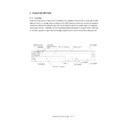Sharp AR-810 (serv.man10) Service Manual ▷ View online
AR-651/810 SCANNING SECTION 6 - 9
6. 4. 3. Control circuit for exposure lamp
HCT00
IC16
HCT00
IC16
HCT00
IC16
P24
+5V
+5VSW
EXPON–0A
PWA–F–SLG–340
EXPON–0
WDTOUT–0
WDTEN–0
P23
IC9
WDTOUT
HC14
IC17
D1:1SS184
Q3:RN2401
Q2:RN1401
SG
Working conditions
WDTOUT-0
WDTEN-0
EXPON-0
+5VSW
Q2
Xenon lamp
State of copier
(Lamp drive signal)
H
H
H
ON
OFF
OFF
Normal operation
H
H
L
ON
ON
ON
L
X
X
OFF
OFF
OFF
Scanner CPU
overdriving
H
L
X
OFF
OFF
OFF
Call for Service
Scanner
CPU
CPU
Xenon lamp
Xenon lamp
lighting device
lighting device
AR-651/810 SCANNING SECTION 6 - 10
6. 5. CCD Control
6. 5. 1. Opto-electronic conversion
A CCD (charge-coupled device) is used to produce an electrical signal corresponding to the reflected light
amount from the original. The CCD is a one-chip opto-electronic conversion device, comprised of several
thousand light-receiving elements arranged in a line; each one of them is a few microns square.
This model is equipped with a CCD which has 7,500 light-receiving elements.
Each element of the light-receiving section consists of the semiconductive layers P and N. When the light
irradiates the element, the light energy produces a (-) charge in the P layer, the amount of the charge
produced is proportional to the energy and irradiating time. The charges produced in the light-receiving
section are then sent to the transfer section where they are shifted by the transfer clock from left to right as
shown in the figure below, and are finally output from the CCD. At this time, to increase the transfer speed
of the CCD, image signals in the even-number and odd-number elements are separated and output in
parallel via two channels.
6. 5. 2. Shading correction
Signal voltages read by the CCD have the following characteristics.
(1) Light source has variation in its light distribution.
(2) Since the light beam reflected from the original is converged using a lens, the light path is the
shortest at the center of the CCD and the longest at ends. This causes difference in the amount of
light reaching the CCD (i.e. the light amount is maximum at the CCD center, gradually decreases
towards the ends).
(3) Each of the 7,500 elements varies slightly in their opto-electronic conversion efficiency.
These variations need to be corrected and this correction is referred to as shading correction. Based on the
black and white data obtained in advance, a normalization process using the following formula is applied to
the raw image data to correct lighting variance and element variation of the image data.
I = k ×
(S — K)
(W — K)
k : Coefficient
S : Image data before correction
K : Black data (stored in “black” memory)
W : White data (stored in “white” memory)
1
7497 7498
7499 7500
2
3
4
Transfer section
Light receiving
section
Transfer section
Shift register
Transfer clock
Light energy
layer N
layer P
Details of light receiving element
Transfer clock
[Principle of the opto-electronic conversion by CCD]
AR-651/810 SCANNING SECTION 6 - 11
6. 6. Automatic Original Size Detection Circuit
This circuit detects the size of original (standard sizes only) using the reflection type photosensors ar-
ranged on the base frame of the scanner unit.
6. 6. 1. Principle of original size detection
The reflection type photosensors are placed on the base frame of the scanner unit as shown in the Fig. 6.6-
1. Each sensor consists of an infrared light emitting diode (LED) on the light emitting side, and a phototransistor
on the light receiving side.
When there is an original on the original glass, light beams from the LEDs are reflected by the original and
led to the phototransistors. This means that the size of the original is detected by checking which
phototransistors are turned on or are not.
6. 6. 2. Process of original size detection
(1) When the copier is in the original size detection mode, the carriage-1 is set at its home position.
(2) When the RADF is opened, the sensors receive the light reflected from the original and if one of the
matrix conditions shown in (4) for original sizes is satisfied, the size of the original is instantly de-
tected.
(3) The output signal from each sensor is input to the CPU on the scanner control PC board to determine
the size of the original.
Fig. 6.6-2 Original size detection circuit
V
DD
P81
33
30
29
28
GND
PWA-SLG
P80
P96
P95
APS-4
APS-3
APS-2
APS-5
Reflection type
photosensor
[LT Series]
[A4 Series]
V
DD
P81
33
32
30
29
28
GND
PWA-SLG
P80
P96
P95
P94
APS-4
APS-3
APS-2
APS-1
APS-5
Reflection type
photosensor
Fig. 6.6-1
Original
Original glass
[A4 Series]
APS-2
APS-3
APS-4
APS-1
APS-5
[LT Series]
Original glass
Original
APS-4
APS-5
APS-3
APS-2
AR-651/810 SCANNING SECTION 6 - 12
[A4 Series]
[LT Series]
Fig.6.6-3 Sensor detection points
ST
LT
LG
LD
ST–R
LT–R
APS-5
APS-4
APS-2
APS-3
A5
B5
A4
B4
A3
A5–R
A4–R
B5–R
APS-5
APS-1
APS-2
APS-3
APS-4
Click on the first or last page to see other AR-810 (serv.man10) service manuals if exist.

